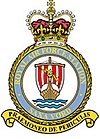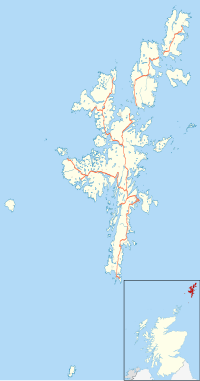Remote Radar Head Saxa Vord or RRH Saxa Vord (aka RAF Saxa Vord), is a Royal Air Force radar station located on the island of Unst, the most northern of the Shetland Islands in Scotland. As of July 2019 it is once more a fully operational radar station,[2] after closure in 2006.[3] The station's motto Praemoneo de Periculis ('Premonition of Peril') reflects its role. RAF Saxa Vord is further north than Saint Petersburg in Russia, and on the same latitude as Anchorage, Alaska. The station was named after Saxa Vord, which is the highest hill on Unst at 935 ft (285 m).[4] It holds the unofficial British record for wind speed, which in 1992 was recorded at 197 mph (317 km/h) — just before the measuring equipment blew away.[5]
| RRH Saxa Vord | |
|---|---|
| Unst, Shetland Islands in Scotland | |
 Radar dome at RRS Saxa Vord. | |
 | |
| Coordinates | 60°49′39″N 0°50′28″W / 60.82750°N 0.84111°W |
| Type | Remote Radar Head |
| Area | 8 hectares (20 acres)[1] |
| Site information | |
| Owner | Ministry of Defence |
| Operator | Royal Air Force |
| Controlled by | No. 1 Group (Air Combat) |
| Condition | Operational |
| Radar type | Lockheed Martin AN/TPS-77 (Type 92) Air Defence Radar |
| Site history | |
| Built | 1957 |
| In use | 2006 – present |
| Garrison information | |
| Occupants | Radar Flight (North) |
History edit
Early years edit
The island of Unst has played an important part in the defence of the UK since the outbreak of the Second World War. By 1945, there were two radar sites on the island – one on Saxa Vord hill, and the other at Skaw on the east coast. This latter is the older, being built in 1941, and was part of the Chain Home radar network as part of the defences of the RAF Sullom Voe flying boat base. Skaw closed in 1947.[6]
ROTOR era edit
As part of the post-war ROTOR radar network, Saxa Vord was selected as the site to host a new long-range radar as the northernmost point in a network of radars covering the entirety of the British Isles. As part of upgrades carried out for ROTOR, Saxa received new radars, the AMES Type 14 medium-range search radar, and associated AMES Type 13 height finders.[7]
While these were being built, a dramatically more powerful system was entering prototype use, the AMES Type 80. The Type 80 had an effective range over 200 nautical miles (370 km; 230 mi), covering the entire Shetland Islands and a significant portion of the Norwegian Sea. The coverage was so vast that there was much less need to tie together multiple stations to provide a wide-area view, and the ROTOR system began to be progressively downgraded to individual Master Radar Stations. Installation of Saxa's Type 80 began in 1955, but was blown 50 yards (46 m) off its mountings by winds gusting to 177 miles per hour (285 km/h) in January 1956.[7]
A new antenna design capable of handling winds of this magnitude was designed as the Mark II, and replaced the original later that year.[8] No. 91 Signals Unit officially formed up at Saxa Vord on 27 September 1957, was declared operational on 5 October 1957, and in 1960 was visited by Queen Elizabeth II.[9]
During this period the Type 14 was retained as a backup system until September 1964, whilst the Type 13 remained the primary height finder until 1978/79. The Type 80 was lost when it was blown away on 26 January 1961 and rebuilt inside a new radome. At the time, Saxa Vord consisted of three sites: the domestic site, the technical site (with the radars) and the married quarters called Setters Hill Estate (SHE). In the early days, the site was shared with the Royal Navy.[7]
Linesman era edit
While the system was being built, serious concerns emerged over the introduction of the carcinotron, a new type of radar jammer that rendered the Type 80 almost useless. A new network using anti-jamming radars was introduced, the Linesman/Mediator system. In the new network, there was no point in Saxa attempting to remain operational against jammers, so it retained its Type 80 while other stations in the chain were upgraded with the new AMES Type 84 and AMES Type 85.[10]
Linesman ran into significant delays, and entered service in limited form in 1973, years later than planned. By 1976, the Type 80 had been in operation for decades and was long overdue for a replacement for maintenance reasons alone. This led to the introduction of a AMES Type 96 (Marconi S649), which had two radar aerials mounted back-to-back, one operating at D band and the other at F and E bands (three transmitters/receivers in total). The decades-old Type 13 was replaced by the newer Plessey HF200 in the height-finder role.[7]
In 1984 the station was renamed from No. 91 Signals Unit to Royal Air Force Saxa Vord. The signals unit badge was adopted by the station and it continued with the motto of Praemoneo de periculis (Latin for I give advanced warning about danger).[11][12]
IUKADGE era edit
By the time Linesman was operational it was considered outdated; much of the equipment was based on decades-old designs, and built using components that were no longer available. Even before it was declared operational the decision had been made to replacing it as soon as possible, A new system, IUKADGE, emerged during a several-year definition process. The system was implemented at Saxa Vord in 1993.[13] This was part of NATO-wide upgrades and the funding for the new radar was provided from the NATO funding pool. This led to one of the six IUKADGE AMES Type 93s being earmarked for Saxa.[14]
Downgrading to Remote Radar Head edit
While the upgrades were taking place, the Warsaw Pact was dissolving and the Soviet Union ceased to exist. The number of intruder flights collapsed and there was no sign they would be returning. From around 2000 until 2 April 2004, the station operated as Remote Radar Head (RRH) Saxa Vord, operated from parent station RAF Buchan. On 2 April 2004, RAF Saxa Vord was upgraded from a Remote Radar Head to a fully staffed station, taking over control of the radar defences in the area.[7]
Closure edit
In 2005, the RAF announced that RRH Saxa Vord would close. The Type 93 radar was approaching obsolescence and was increasingly difficult to maintain. It was considered that with a reduced threat, funding would be diverted to other defence priorities.[15]
RRH Saxa Vord closed in April 2006 with the site being placed on programme of care and maintenance and the radar being dismantled and used for spares in other Type 93 radars.[16][15]
In April 2007, Saxa Vord's Domestic Site and the road up to the Mid Site were bought by Military Asset Management (MAM).[17]
Reactivation as RRH edit
In September 2017, the Ministry of Defence confirmed that £10 million would be invested in Saxa Vord to reactivate the site as a Remote Radar Head. The move will provide better coverage of the airspace to the north of the UK, in response to increased Russian military activity.[18][19] Work began in October 2017 to move a Lockheed Martin AN/TPS-77 L-band radar from RRH Staxton Wold in North Yorkshire to Saxa Vord.[20]
During January 2018, Chief of the Air Staff, Air Chief Marshal Sir Stephen Hillier visited the site to inspect progress and the new radar reached initial operational capability. It was expected to reach full operational capability by the end of 2018.[19][21]
As part of a major upgrade of RRH sites around the U.K. the MOD began a programme titled HYDRA in 2020 to install new state of the art communications buildings, radar towers and bespoke perimeter security.[22][23]
Nobody will be permanently based at Saxa Vord, but regular visits will take place for maintenance purposes.[18]
Some of the former base facilities are now in use as the Saxa Vord distillery and the proposed SaxaVord Spaceport.[24]
See also edit
- Improved United Kingdom Air Defence Ground Environment – UK air defence radar system in the UK between the 1990s and 2000s
- Linesman/Mediator – UK air defence radar system in the UK between the 1960s and 1984
- List of Royal Air Force stations
- NATO Integrated Air Defense System
- Coastal fortifications in Scotland
References edit
- ^ "Defence Estates Development Plan 2009 – Annex A". GOV.UK. Ministry of Defence. 3 July 2009. p. 3. Retrieved 30 April 2019.
- ^ "UK RAF RADAR COVERAGE TO BE ENHANCED". Mönch Verlagsgesellschaft mbH. 21 September 2017. Retrieved 5 February 2018.
- ^ Newton, Grace (17 September 2017). "RAF re-open radar base on Britain's most northerly island". The Yorkshire Post. Retrieved 8 March 2018.
- ^ MacLeod, Angus (22 July 2005). "Island faces bleak future as RAF abandons base". The Times. p. 25. ISSN 0140-0460.
- ^ "The Storm – New Year 1991/92 Part 1". A history of RAF Saxa Vord. 10 July 2010. Retrieved 27 July 2019.
- ^ "Orkney and Shetland". Scottish Aviation Trail. Retrieved 18 February 2022.
- ^ a b c d e "Saxa Vord Rotor Radar Station". Subterranea Britannica. Retrieved 18 February 2022.
- ^ McCamley, Nick (31 May 2013). Cold War Secret Nuclear Bunkers. p. 87. ISBN 9781844155088.
- ^ "Royal Tour of the Isles". Shetland Times. 1960.
- ^ Gough, Jack (1993). Watching the skies: a history of ground radar for the air defence of the United Kingdom by the Royal Air Force from 1946 to 1975. HMSO. p. 175. ISBN 978-0-11-772723-6.
- ^ Pine, L.G. (1983). A dictionary of mottoes (1 ed.). London: Routledge & Kegan Paul. p. 178. ISBN 0-7100-9339-X.
- ^ "No.91 Signals Unit | RAF Heraldry Trust". rafht.co.uk. Retrieved 8 March 2018.
- ^ Brown, John. "Improved UK Air Defence Ground Environment – IUKADGE - Concept and Implementation".
- ^ Historic Environment Scotland. "Unst, Saxa Vord, Royal Air Force (Raf) Saxa Vord (282548)". Canmore. Retrieved 19 February 2022.
- ^ a b "Organisational Changes to the RAF – Drawdown of RAF Saxa Vord". Royal Air Force. 27 October 2005. Archived from the original on 10 August 2006. Retrieved 16 May 2005.
- ^ Harper, Tom (17 September 2017). "RAF reopens Shetland radar site Saxa Vord to sweep for Russia threat". The Sunday Times. Retrieved 8 March 2018.
- ^ "Future bright for Saxa Vord". Shetland News. 29 March 2010. Retrieved 18 February 2022.
- ^ a b Cope, Chris (16 September 2017). "Unst radar base work to begin in October". Shetland News. Shetland News Online Ltd. Retrieved 18 September 2017.
- ^ a b "New Shetland radar to better protect UK northern airspace". Royal Air Force. 26 January 2018. Retrieved 28 February 2018.
- ^ Withington, Thomas (21 September 2017). "UK RAF radar coverage to be enhanced". Mönch Publishing Group. Retrieved 28 February 2018.
- ^ Bebb, Guto (27 February 2018). "RAF Saxa Vord:Written question - 129067". UK Parliament. Retrieved 28 February 2018.
- ^ "Upgrading RAF Remote Radar Heads". 17 June 2021.
- ^ "Behind the scenes of Programme HYDRA". 23 June 2021.
- ^ "Shetland space launch plans submitted". BBC News. 18 January 2021. Retrieved 23 January 2021.
